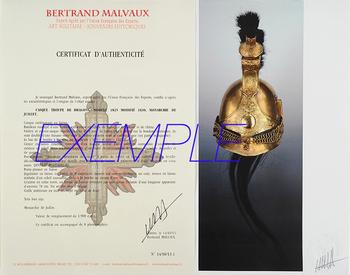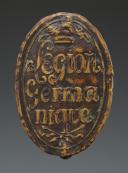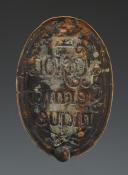
GERMANIC LEGION BELT PLATE OR ARMBAND, ALSO KNOWN AS THE ROSENTHAL LEGION, FRENCH REVOLUTION (1792-1793). 29246-5
BRASSARD OR ARMBAND OF THE GERMAN LEGION also known as THE ROSENTHAL LEGION, Revolution (1792-1793). 29246-5
Oval-shaped embossed copper plaque, H 8 cm, L 5 cm. It is embossed in relief with two crossed pikes surmounted by the inscription "German Legion" and bordered at the top by a Phrygian cap.
France.
Revolution (1792-1793).
Good condition.
HISTORICAL BACKGROUND:
The German Legion, also known as the Rosenthal Legion, was a military unit theoretically composed of German volunteers fighting under French command. Created on September 4, 1792, it was dissolved on June 27, 1793, to form the "Legion of Fraternity."
Formation
The idea of forming an army corps with patriotic German volunteers (referring to sympathizers of the French Revolution) was born during the summer of 1792. The examples of the Legion of United Belgians and Liégeois likely inspired the Prussian Anacharsis Cloots and the Saxon Saiffert, both residing in Paris, to conceive a legion initially called the Prussian Legion, later renamed the Vandalic Legion.
A recruitment issue quickly arose as there were few patriotic German emigrants in France. Cloots then came up with the idea of recruiting deserters from Austrian and Prussian troops. A decree by the Legislative Assembly in August 1792 granted these deserters a lifelong pension of 100 livres. In the minds of Cloots and the military adjutants Colonels Dambach and van Hayden, the German Legion was not only meant to be a refuge for deserters but also the "nucleus of future German liberty." Saiffert composed a hymn with the refrain: "Rise up oppressed people; stand up, you who speak the same language, be free like the French."
A "capitulation" (treaty) was concluded between the leaders of the future legion and the War Ministry, stipulating that the legion would not engage against Austrian or German troops and would not accept any French personnel.
The legion's existence was officially recognized by a law on September 4, 1792. Soon after, the capitulation was violated, and the legion accepted not only Germans, Prussians, and Dutch but also French volunteers, mainly from German-speaking Alsace and Lorraine. Marceau and Augereau were among the legion members.
One of the most significant recruitment sources was among former Swiss Guards: nearly 300 of those who survived the Tuileries’ capture opted to join the French army, specifically this legion where they could find other German speakers.
History
Initially deployed to restore order in the Chartres region, the legion was sent to the Ardennes front, contradicting the capitulation. After the Vendéan uprising, the legion was dispatched to the West. Around the same time, accusations of "despotism" were leveled against legion leaders, and some officers, like Marceau, were relieved of duty by the mission representatives in Vendée. Many of the Swiss, former guards of King Louis XVI, deserted to join the Catholic and Royalist army, followed by other German speakers. For example, after the battle of Saumur on June 9, many soldiers from the German Legion, including the liberated Swiss, joined the Vendéans.
By June 1793, the legion only had around a thousand men, down from 2,599 at its departure from Belgium. Following these events, the legion was dissolved on either June 22 or 27, 1793, and its members were regrouped under the name "Legion of Fraternity," led by Colonel Louis Paul de Beffroy and Lieutenant Colonel Burac. According to Jérôme Croyet, the infantry formed the 22nd chasseurs battalion and the hussars the 11th hussars. According to Charles-Louis Chassin, the infantry formed the 11th chasseurs battalion, incorporated on December 22 into the 13th light brigade, and the cavalry formed the 19th regiment of cavalry chasseurs. A death certificate for a certain Schelegue, issued by the 22nd infantry regiment in Saumur in the year 2 of the Republic, states that he was part of the German Legion at its creation moment, and within the 22nd regiment extracted from the legion, he professed the principles of pure republicanism.
Soldiers of the German Legion participated in the shootings and drownings in Nantes as perpetrators, while those who had joined the Vendéan cause and were captured fell victim to these executions.
Notable Personalities
- Claude François Thomas Sandoz, then Chief Lieutenant Colonel of the Arquebusiers
- François Séverin Marceau, then Lieutenant of the Light Cuirassiers
- Pierre Ismert, then Lieutenant of the Light Cuirassiers
Oval-shaped embossed copper plaque, H 8 cm, L 5 cm. It is embossed in relief with two crossed pikes surmounted by the inscription "German Legion" and bordered at the top by a Phrygian cap.
France.
Revolution (1792-1793).
Good condition.
HISTORICAL BACKGROUND:
The German Legion, also known as the Rosenthal Legion, was a military unit theoretically composed of German volunteers fighting under French command. Created on September 4, 1792, it was dissolved on June 27, 1793, to form the "Legion of Fraternity."
Formation
The idea of forming an army corps with patriotic German volunteers (referring to sympathizers of the French Revolution) was born during the summer of 1792. The examples of the Legion of United Belgians and Liégeois likely inspired the Prussian Anacharsis Cloots and the Saxon Saiffert, both residing in Paris, to conceive a legion initially called the Prussian Legion, later renamed the Vandalic Legion.
A recruitment issue quickly arose as there were few patriotic German emigrants in France. Cloots then came up with the idea of recruiting deserters from Austrian and Prussian troops. A decree by the Legislative Assembly in August 1792 granted these deserters a lifelong pension of 100 livres. In the minds of Cloots and the military adjutants Colonels Dambach and van Hayden, the German Legion was not only meant to be a refuge for deserters but also the "nucleus of future German liberty." Saiffert composed a hymn with the refrain: "Rise up oppressed people; stand up, you who speak the same language, be free like the French."
A "capitulation" (treaty) was concluded between the leaders of the future legion and the War Ministry, stipulating that the legion would not engage against Austrian or German troops and would not accept any French personnel.
The legion's existence was officially recognized by a law on September 4, 1792. Soon after, the capitulation was violated, and the legion accepted not only Germans, Prussians, and Dutch but also French volunteers, mainly from German-speaking Alsace and Lorraine. Marceau and Augereau were among the legion members.
One of the most significant recruitment sources was among former Swiss Guards: nearly 300 of those who survived the Tuileries’ capture opted to join the French army, specifically this legion where they could find other German speakers.
History
Initially deployed to restore order in the Chartres region, the legion was sent to the Ardennes front, contradicting the capitulation. After the Vendéan uprising, the legion was dispatched to the West. Around the same time, accusations of "despotism" were leveled against legion leaders, and some officers, like Marceau, were relieved of duty by the mission representatives in Vendée. Many of the Swiss, former guards of King Louis XVI, deserted to join the Catholic and Royalist army, followed by other German speakers. For example, after the battle of Saumur on June 9, many soldiers from the German Legion, including the liberated Swiss, joined the Vendéans.
By June 1793, the legion only had around a thousand men, down from 2,599 at its departure from Belgium. Following these events, the legion was dissolved on either June 22 or 27, 1793, and its members were regrouped under the name "Legion of Fraternity," led by Colonel Louis Paul de Beffroy and Lieutenant Colonel Burac. According to Jérôme Croyet, the infantry formed the 22nd chasseurs battalion and the hussars the 11th hussars. According to Charles-Louis Chassin, the infantry formed the 11th chasseurs battalion, incorporated on December 22 into the 13th light brigade, and the cavalry formed the 19th regiment of cavalry chasseurs. A death certificate for a certain Schelegue, issued by the 22nd infantry regiment in Saumur in the year 2 of the Republic, states that he was part of the German Legion at its creation moment, and within the 22nd regiment extracted from the legion, he professed the principles of pure republicanism.
Soldiers of the German Legion participated in the shootings and drownings in Nantes as perpetrators, while those who had joined the Vendéan cause and were captured fell victim to these executions.
Notable Personalities
- Claude François Thomas Sandoz, then Chief Lieutenant Colonel of the Arquebusiers
- François Séverin Marceau, then Lieutenant of the Light Cuirassiers
- Pierre Ismert, then Lieutenant of the Light Cuirassiers
Price :
1 000,00 €
| Destination | Envoi recommandé | Envoi Recommandé + Express |
|---|---|---|
| Shipping France | 9,00 € | 30,00 € |
| Shipping Europe | 17,00 € | 50,00 € |
| Shipping world | 30,00 € | 70,00 € |
Insurance (1%) :
10,00 €
Reference :
29246-5

Next update Friday, december 26 at 13:30 PM
FOR ALL PURCHASES, PAYMENT IN MULTIPLE CHECKS POSSIBLE
bertrand.malvaux@wanadoo.fr 06 07 75 74 63
SHIPPING COSTS
Shipping costs are calculated only once per order for one or more items, all shipments are sent via registered mail, as this is the only way to have proof of dispatch and receipt.
For parcels whose value cannot be insured by the Post, shipments are entrusted to DHL or Fedex with real value insured, the service is of high quality but the cost is higher.
RETURN POLICY
Items can be returned within 8 days of receipt. They must be returned by registered mail at the sender's expense, in their original packaging, and in their original condition.
AUTHENTICITY
The selection of items offered on this site allows me to guarantee the authenticity of each piece described here, all items offered are guaranteed to be period and authentic, unless otherwise noted or restricted in the description.
An authenticity certificate of the item including the description published on the site, the period, the sale price, accompanied by one or more color photographs is automatically provided for any item priced over 130 euros. Below this price, each certificate is charged 5 euros.
Only items sold by me are subject to an authenticity certificate, I do not provide any expert reports for items sold by third parties (colleagues or collectors).
FOR ALL PURCHASES, PAYMENT IN MULTIPLE CHECKS POSSIBLE
bertrand.malvaux@wanadoo.fr 06 07 75 74 63
An authenticity certificate of the item including the description published on the site, the period, the sale price, accompanied by one or more color photographs is automatically provided for any item priced over 130 euros. Below this price, each certificate is charged 5 euros.
Only items sold by me are subject to an authenticity certificate, I do not provide any expert reports for items sold by third parties (colleagues or collectors).

